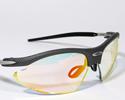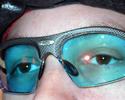
Sports Optical prescription sunglasses
By Mark Zalewski, North American Editor
Riders requiring prescription
eyewear
Photo ©: Mark Zalewski

|
|
Hunter has also developed
his own lens shape
Photo ©: Mark Zalewski

|
|
Sports Optical lenses
integrate the user's prescription
Photo ©: Mark Zalewski

|
|
The lenses are undoubtedly
expensive
Photo ©: Mark Zalewski

|
|
Riders requiring corrective lenses have typically had to resort
to one of three options if they wanted to take advantage of some
of the excellent eyewear offerings currently on the market: contact
lenses, corrective surgery, or prescription sunglass inserts. Secondary
clip-on frames are the norm for the latter although some newer variants
integrate inserts that replace part of the lens itself. Neither
is ideal, though, as secondary frames are often bulky and heavy
and neither carry their corrective powers out to the edges of the
lens.
Bret Hunter, owner of Sports Optical, believes he has the answer
with his Direct Lens Technology which replaces the entire stock
lens with a precision-fit Rx version. According to Hunter, the new
lens retains all of the performance features of the original but
with corrected vision from edge to edge and decreased weight as
compared to conventional solutions. Hunter currently offers 21 lens
colours in all including photochromics.
The best part is Hunter supposedly has the capability to replicate
almost any lens shape from almost any manufacturer's interchangeable
lens frame. "We can work with just about any frame - it depends
on the prescription and the frame," said Hunter. "We are a dealer
in Rudy Project, Smith and Adidas. Rudy Project is really good for
the internet because they are so adjustable. But we do lenses for
Oakley and other brands too."
I can see clearly now...
Our test set came with three sets of lenses to fit our tester's
favorite old reliable Rudy Project Ekynox SX frame. The first was
a gray polarizing lens with an added glare-reducing blue mirror
finish rated at just 10% transmission for sunny days. The second
bore a high-contrast red tint for low-light, overcast, or flat lighting
conditions and the option number three was a requisite clear lens
augmented with a light anti-reflective coating to reduce glare.
An added surprise was a new Rudy Project Rydon frame with an original
custom lens shape that Hunter calls 'K'. These lenses were also
photochromic, adjusting in darkness from a red tint to clear to
suit a wider variety of conditions without having to swap optics.
Naturally, Hunter's lenses are thicker than stock to accommodate
our mild -1.50/-1.75 diopter prescription but they still fit into
the same slot in the frame. Swapping lenses was a bit more difficult
than usual, although we were admittedly a bit more cautious than
usual.
Hunter's formula is noticeable, but in a good way as being able
to see out of the side of the glasses is a real treat and we can
comfortably say that these glasses lived up to our lofty expectations..
Hunter's proprietary 'K' shape was quite unique and provided great
coverage around our eyes. The photochromic quality of the lens is
seemingly slight from an outsider's perspective, but quite noticeable
and effective when looking through the lens in variable light conditions.
The only slight drawback we noticed came with the gray lens. There
was something about the polarizing quality combined with the dark
lens that created some issues with perception of the road surface.
Dark colours that were close to other dark colours - such as two
types of asphalt on the road - yielded a mirage quality that we
didn't notice in any of the other lenses.
Unfortunately, this level of convenience and performance comes
with a hefty premium. For example, the traditional gray polarizing
lens will run you US$279, well above the cost of an entire non-Rx
frame and lens combination. For those who have struggled with uncomfortable
contact lenses or inadequate inserts, though, the cost may be well
worth it as we found the change to be enlightening to say the least.
In our opinion, it is difficult to put a price on quality vision
and that is nothing to skimp on.
Price: US$359 ('K' photochromic); US$279 (gray polarized,
blue mirror); US$159 (red); US$199 (clear), prices do not include
frames
Pros: Unique product, versatile across multiple brands, quality
craftsmanship
Cons: Only for prescription users, costly
Cyclingnews rating: 
More info: www.sportsoptical.com
PhotographyFor a thumbnail gallery of these images, click here
Images by
Mark Zalewski/Cyclingnews.com
|

